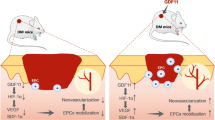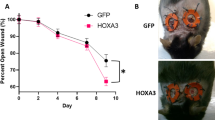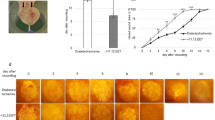Abstract
It has been previously shown that vascular endothelial growth factor (VEGF) plays a central role in promoting angiogenesis during wound repair and that healing-impaired diabetic mice show decreased VEGF expression levels. In order to investigate the potential benefits of gene therapy with growth factors on wound repair, a replication-deficient recombinant adenovirus vector carrying the human VEGF165 gene (AdCMV.VEGF165) was topically applied on excisional wounds of streptozotocin-induced diabetic mice. Treatment with AdCMV.VEGF165 significantly accelerated wound closure when compared with AdCMV.LacZ-treated, as well as saline-treated control mice, by promoting angiogenesis at the site of injury. Our findings suggest that AdCMV.VEGF165 may be regarded as a therapeutic tool for the treatment of diabetic ulcers.
This is a preview of subscription content, access via your institution
Access options
Subscribe to this journal
Receive 12 print issues and online access
$259.00 per year
only $21.58 per issue
Buy this article
- Purchase on Springer Link
- Instant access to full article PDF
Prices may be subject to local taxes which are calculated during checkout






Similar content being viewed by others
References
Clark RAF . Biology of dermal wound repair Dermatol Clin 1993 11: 647–666
Folkman J . Angiogenesis: initiation and control Ann NY Acad Sci 1982 401: 212–227
Robinson CJ et al. The splice variants of vascular endothelial growth factor (VEGF) and their receptors J Cell Sci 2001 5: 853–865
Leung DW et al. Vascular endothelial growth factor is a secreted angiogenic mitogen Science 1989 246: 1306–1309
Keck PJ et al. Vascular permeability factor, an endothelial cell mitogen related to PDGF Science 1989 8: 1309–1312
Richard DE et al. Angiogenesis: how a tumor adapts to hypoxia Biochem Biophys Res Commun 1999 266: 718–722
Nissen N et al. Vascular endothelial growth factor mediates angiogenic activity during the proliferative phase of wound healing Am J Pathol 1998 152: 1445–1452
Detmar M et al. Overexpression of vascular permeability factor/vascular endothelial growth factor and its receptors in psoriasis J Exp Med 1994 180: 1141–1146
Detmar M et al. Keratinocyte-derived vascular permeability factor (vascular endothelial growth factor) is a potent mitogen for dermal microvascular endothelial cells J Invest Dermatol 1995 105: 44–50
Ballaun C et al. Human keratinocytes express the three major splice forms of vascular endothelial growth factor J Invest Dermatol 1995 104: 7–10
Frank S et al. Regulation of vascular endothelial growth factor expression in cultured keratinocytes. Implications for normal and impaired wound healing J Biol Chem 1995 270: 12607–12613
Detmar M . Molecular regulation of angiogenesis in the skin J Invest Dermatol 1996 106: 207–208
Detmar M et al. Increased microvascular density and enhanced leukocyte rolling and adhesion in the skin of VEGF transgenic mice J Invest Dermatol 1998 111: 1–6
Kishimoto J et al. In vivo detection of human vascular endothelial growth factor promoter activity in transgenic mouse skin Am J Pathol 2000 157: 103–110
Matsuda H et al. Role of nerve growth factor in cutaneous wound healing: accelerating effects in normal and healing-impaired diabetic mice J Exp Med 1998 187: 297–306
Bitar MS . Glucocorticoid dynamics and impaired wound healing in diabetes mellitus Am J Pathol 1998 152: 547–554
Brown DL et al. Differential expression and localization of insulin-like growth factors I and II in cutaneous wounds of diabetic and nondiabetic mice Am J Pathol 1997 151: 715–724
Miller AD . Human gene therapy comes of age Nature 1992 357: 455–460
Mulligan RC . The basic science of gene therapy Science 1993 260: 926–932
Bajocchi G et al. Direct in vivo gene transfer to ependymal cells in the central nervous system using recombinant adenovirus vectors Nat Genet 1993 3: 229–234
Setoguchi Y et al. Ex vivo and in vivo gene transfer to the skin using replication-deficient recombinant adenovirus vectors J Invest Dermatol 1994 102: 415–421
Setoguchi Y et al. Ex vivo and in vivo gene transfer to the skin using replication-deficient recombinant adenovirus vectors Boulton AJ. The diabetic foot: a global view. Diabet Metab Res Rev 2000; 16 (Suppl. 1): S2–S5.
Zimny S et al. Early detection of microcirculatory impairment in diabetic patients with foot at risk Diabetes Care 2001 24: 1810–1814
Woon Ji-Won . Cellular and molecular pathogenic mechanisms of insulin-dependent diabetes mellitus Ann NY Acad Sci 2001 928: 200–211
Rivard A et al. Rescue of diabetes-related impairment of angiogenesis by intramuscular gene therapy with adeno-VEGF Am J Pathol 1999 154: 355–363
Coleman DL et al. Obese and diabetes: two mutant genes causing diabetes- obesity syndrome in mice Diabetologia 1978 14: 141–148
Inaba M et al. Partial protection of 1 alpha-hydroxyvitamin D3 against the development of diabetes induced by multiple low-dose streptozotocin injection in CD-1 mice Metabolism 1992 41: 631–635
Corral CJ et al. Vascular endothelial growth factor is more important than basic fibroblastic growth factor during ischemic wound healing Arch Surg 1999 134: 200–205
Lorenzi M et al. High glucose prolongs cell-cycle traversal of cultured human endothelial cells Diabetes 1987 36: 1261–1267
Curcio F et al. Decreased cultured endothelial cell proliferation in high glucose medium is reversed by antioxidants: new insights on the pathophysiological mechanisms of diabetic vascular complications In Vitro Cell Dev Biol 1992 28: 787–790
Brown LF et al. Expression of vascular permeability factor (vascular endothelial growth factor) by epidermal keratinocytes during wound healing J Exp Med 1992 176: 1375–1379
Peters KG et al. Vascular endothelial growth factor receptor expression during embryogenesis and tissue repair suggests a role in endothelial differentiation and blood vessel growth Proc Natl Acad Sci USA 1993 90: 8915–8919
Greenhalgh DG et al. PDGF and FGF stimulate wound healing in the genetically diabetic mice Am J Pathol 1990 136: 1235–1246
Robson MC et al. The safety and effect of topically applied recombinant basic fibroblast growth factor on the healing of chronic pressure sores Ann Surg 1992 216: 401–406
Marques da Costa R . Double-blind randomized placebo-controlled trial of the use of granulocyte–macrophage colony-stimulating factor in chronic leg ulcers Am J Surg 1997 173: 165–168
Safi J Jr et al. Adenovirus-mediated acidic fibroblast growth factor gene transfer induces angiogenesis in the nonischemic rabbit heart Microvasc Res 1999 58: 238–249
Rosengart TK et al. Angiogenesis gene therapy: phase I assessment of direct intramyocardial administration of an adenovirus vector expressing VEGF121 cDNA to individuals with clinically significant severe coronary artery disease Circulation 1999 100: 468–474
Sun L et al. Transfection with aFGF cDNA improves wound healing J Invest Dermatol 1997 108: 313–318
Yamasaki K et al. Reversal of impaired wound repair in iNOS-deficient mice by topical adenoviral-mediated iNOS gene transfer J Clin Invest 1998 101: 967–971
Liechty KW et al. Adenoviral-mediated overexpression of platelet-derived growth factor-B corrects ischemic impaired wound healing J Invest Dermatol 1999 113: 375–383
Vale PR et al. Left ventricular electromechanical mapping to asses efficacy of phVEGF (165) gene transfer for therapeutic angiogenesis in chronic myocardial ischemia Circulation 2000 102: 965–974
Leek RD et al. Macrophage infiltration is associated with VEGF and EGFR expression in breast cancer J Pathol 2000 190: 430–436
Muhlhauser J et al. VEGF165 expressed by a replication-deficient recombinant adenovirus vector induces angiogenesis in vivo Circ Res 1995 77: 1077–1086
Sai P et al. Effects of cyclosporin on autoimmune diabetes induced in mice by streptozotocin: beta cell-toxicity and rebound of insulitis after cessation of treatment Diabet Metab 1988 14: 455–462
Gowdak LH et al. Adenovirus-mediated VEGF(121) gene transfer stimulates angiogenesis in normoperfused skeletal muscle and preserves tissue perfusion after induction of ischemia Circulation 2000 102: 565–571
Anversa P, Capasso JM . Loss of intermediate-sized coronary arteries and capillary proliferation after left ventricular failure in rats Am J Physiol 1991 260: H1552–H1560
Author information
Authors and Affiliations
Rights and permissions
About this article
Cite this article
Romano Di Peppe, S., Mangoni, A., Zambruno, G. et al. Adenovirus-mediated VEGF165 gene transfer enhances wound healing by promoting angiogenesis in CD1 diabetic mice. Gene Ther 9, 1271–1277 (2002). https://doi.org/10.1038/sj.gt.3301798
Received:
Accepted:
Published:
Issue Date:
DOI: https://doi.org/10.1038/sj.gt.3301798
Keywords
This article is cited by
-
The Electrospun Fibrous Membrane Containing Pomegranate Seed Extract/Polyvinyl Alcohol Improves Infectious Wound Healing in Wistar Rats
Fibers and Polymers (2023)
-
Basic concepts, current evidence, and future potential for gene therapy in managing cutaneous wounds
Biotechnology Letters (2019)
-
Exendin-4 in combination with adipose-derived stem cells promotes angiogenesis and improves diabetic wound healing
Journal of Translational Medicine (2017)
-
Interleukin-22 Promotes Wound Repair in Diabetes by Improving Keratinocyte Pro-Healing Functions
Journal of Investigative Dermatology (2015)
-
PDGFRα plays a crucial role in connective tissue remodeling
Scientific Reports (2015)



